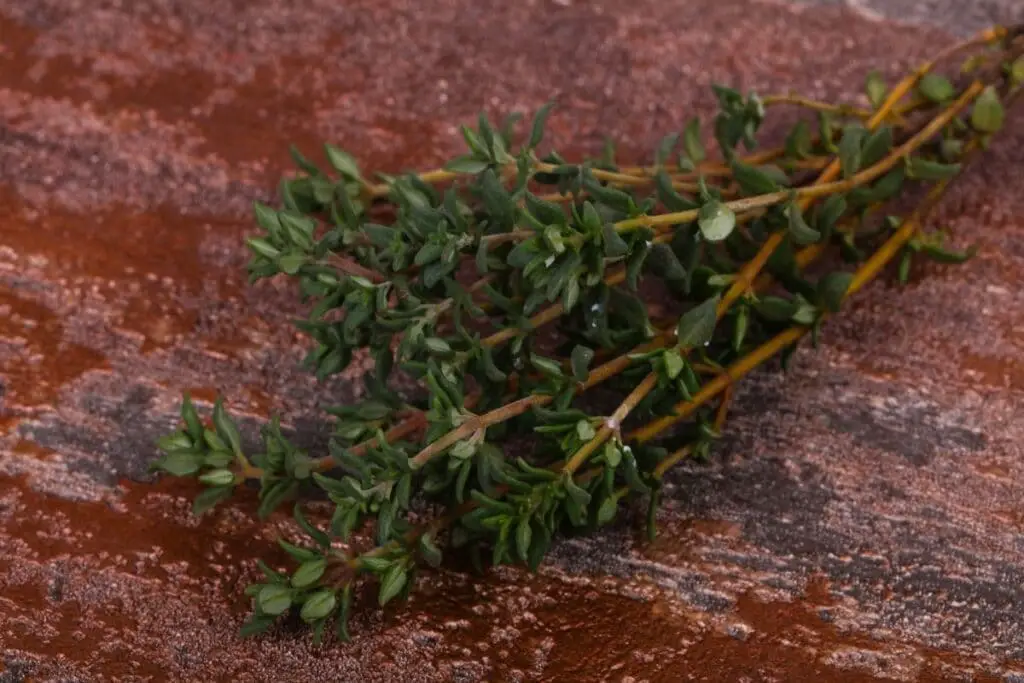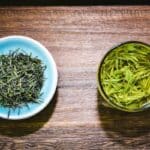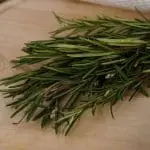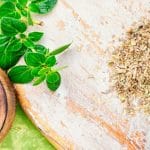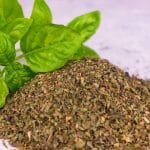Briefly, the best alternatives to thyme are oregano, basil, rosemary, marjoram, etc. Each alternative offers a slightly different flavor profile and texture but can be used in similar dishes and preparations.
Thyme is a Mediterranean herb that has been popularly used for medicinal, ornamental, and culinary purposes for centuries by the ancient Egyptians and Greeks. You may see thyme or thyme oil in the ingredients list of some modern cosmetic products for its antimicrobial and antifungal properties.
When it comes to cooking, thyme is popular in Italian cuisine and is incredibly versatile pairing well with meat, chicken, pork, vegetables, and salads.
If you’re making a hearty meal and your recipe calls for thyme, but there’s none in the pantry, there are some alternatives that can bring just as much Mediterranean flair to your dish. In this cooking guide, we’ll help you choose the best substitute for thyme according to the type of dish you are cooking.
What Is Thyme?
Thyme, oregano, basil, mint, and shiso all belong to the same Mediterranean herb family. Its small leaves grow in clusters on thin woody stalks.
Common thyme, which is often purchased fresh or dried in grocery stores, has a slightly woody, earthy flavor with mint and lemon undertones. There are however many varieties of fresh thyme including lemon thyme and caraway thyme.
Although mostly used in savory dishes, there are a few nuanced sweet applications that can incorporate it too. It is popularly used in Italian salad dressing, roast potatoes, roast chicken, turkey, stuffing and adds a great depth of flavor to meat dishes and stews. It pairs well with garlic and lemon, which are an ideal combination with seafood.
When choosing a replacement for thyme, it may be beneficial for you to determine exactly which quality of the herb is important to you in your dish. Is it the woody notes of lemon and mint accents that you want to accentuate, or purely the herbaceous complexity and aromas? Identifying this will help you choose the best thyme substitute for your specific application.
To use fresh thyme in your cooking, run your thumb and forefinger down the stem to gently push the leaves off and chop them if desired before adding to your dish.
Remember that dried herbs, in general, are more concentrated than their fresh counterparts, meaning you will use less of the dried product in your recipe. One tablespoon of fresh herbs is equal to one teaspoon of the same herbs in their dried form.
Best Substitutes for Thyme
1. Oregano
Since oregano and thyme are both from the mint family, this is probably one of the best single herb substitutes you can use to achieve similar earthy, savory, and slightly minty notes. It is often associated with pizza and also combines well with southern Italian spicy dishes.
Dried and ground, the herb is often used with lemon olive oil over Greek salad and grilled fish. Be careful when using dried herbs not to overpower the rest of the flavors in your dish. Rather start with a small amount and add to taste.
Best used in: Chicken, meat, fish, pork, vegetable dishes, savory baked items, pasta and pizza sauces, and salad dressings.
Substitute quantity:
- Replace fresh oregano for fresh thyme in equal quantities
- Replace dried oregano for dried thyme in equal quantities
- When using fresh oregano as a replacement for dried thyme, use double the recommended amount. For example, if your recipe requires 1 teaspoon of dried herbs, use 2 teaspoons of fresh oregano.
- Similarly, if you are using dried herbs to replace fresh thyme, use only half the recommended amount since dried herbs are more potent.
2. Marjoram
Marjoram is preferred in the north of Italy as opposed to oregano. It has similar undertones, but with a slightly sweeter and more delicate flavor. Fresh marjoram is popular in North Africa and Mediterranean cuisine, as well as in Western Asia. It is commonly used as a garnish for soups, salads, and meat dishes.
Best used in: Chicken, meat, fish, and vegetable dishes, pasta and pizza sauces, as well as salad dressings.
Substitute quantity: Follow the same guidelines as you would for oregano, considering whether you are replacing fresh or dried herbs.
Related: Substitute for marjoram
3. Basil
Basil leaves are much larger and more delicate than thyme. They have a fresh and pronounced flavor with licorice notes. Basil is also an Italian staple used in pesto, pasta, and as a salad green mixed with other fresh herbs.
Best used in: Chicken, fish, and vegetable recipes, as well as pasta, pizza, salad, egg dishes, dips, and dressings. Basil can also be incorporated subtly into sweet dishes.
Substitute quantity: Due to its strong fresh flavor, basil is best used in half the amount required. If your recipe calls for 2 teaspoons of fresh thyme, only use 1 teaspoon of fresh basil. When dried, basil is somewhat muted and can therefore be swapped in equal quantities and increased to taste if necessary.
4. Savory
Savory has a more peppery and spicy flavor than thyme. It is, however, from the same herb family and can also make a suitable substitute in both fresh and dry forms. The herb is available in the common summer savory variety or winter savory, which has a more earthy taste.
Best used in: Seasonings for grilled meats, poultry, stews, and sauces.
Substitute quantity:
- Replace fresh savory for fresh thyme in equal quantities
- Replace dried savory for dried thyme in equal quantities
- When using fresh savory as a replacement for dried thyme, use double the recommended amount.
- Similarly, if you are using dried herbs to replace fresh ones, use only half the recommended amount.
5. Rosemary
Rosemary is a less tender and more woody type herb with needle-like leaves and an earthy lemon-pine taste. It has a pronounced flavor, so add in small amounts to prevent it from overpowering your dish. Only the leaves are used for cooking, however, the whole stalk can be added to dishes to impart flavor and removed before serving.
Best used in: Lamb dishes, focaccia with garlic and olive oil as well as tomato sauce, pork, poultry, and vegetables.
Substitute quantity: Use a slightly smaller amount than what the recipe calls for, and thereafter adjust to taste.
6. Tarragon
Tarragon has a distinctive taste, with hints of mint and anise. It is often used in French cuisine and may be less versatile as a replacement.
Best used in: Chicken and fish dishes, as well as stews and sauces.
Substitute quantity: If you are familiar with the taste of tarragon, replace it measure for measure. If you are unsure of the flavor in your dish, add less to start with and adjust according to taste.
Related: Tarragon replacement
7. Fresh Herb Mixes
You can substitute thyme with a dried or fresh herb mix of various kinds. For recipes where you require a bouquet garni to season stews, meat, and soups, it is best to use sprigs of marjoram, rosemary, oregano, and savory but do not use basil as it does not hold up as well to heat and will become mushy. It may also overpower the other flavors as it dissolves into the dish.
Best used in: Chicken, meat, fish, pork, vegetable dishes, savory baked items, pasta and pizza sauces, and salad dressings.
Substitute quantity:
- Replace fresh mixed herbs in equal quantities with fresh thyme.
- Replace dried mixed herbs in equal quantities when replacing dried thyme.
Spice Blends
The below spice blends contain thyme as part of a mix of herbs and spices, which makes them suitable to substitute dried thyme in equal quantities in savory recipes. In place of fresh thyme, only use half the amount required in the recipe.
Keep in mind that many of these spice blends may contain powdered aromatics and preservatives or anti-caking agents to prolong their shelf-life.
8. Italian Seasoning
This is made up of a mixture of dried herbs including basil, rosemary, marjoram, thyme, and oregano. It is great with almost any savory dish that has a Mediterranean flair including vegetables, salads, dressings, chicken, fish, meat, and pasta sauces.
9. Za’atar
Hold off on the addition of salt when using za’atar as a replacement, as it may already include salt in the blend. Once you have added the za’atar to your dish, add salt if needed according to taste afterward. This blend contains toasted sesame seeds, sumac, dried thyme, oregano, and marjoram.
10. Poultry seasoning
This may vary slightly according to the manufacturer but is a great substitute and generally includes thyme, nutmeg, sage, marjoram, black pepper, and rosemary.
FAQs
Conclusion
Thyme is a versatile herb that can be used in almost any savory dish from seafood and poultry to pork, meat, vegetables, savory bread, and salad dressing. It is synonymous with Mediterranean flavors.
When choosing a replacement, consider whether your recipe calls for fresh or dried herbs and try to use an alternative of the same type.
If you only have dried herbs instead of fresh on hand, remember that they are slightly more compact in flavor, so you can use a little less than what is required in the recipe.
See more:
*image by AndreySt/depositphotos
